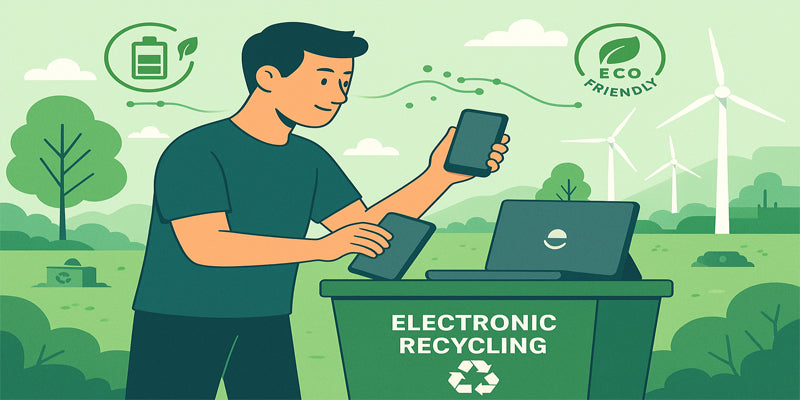Why Recycling Matters for a Greener Future
In today's world, recycling saves energy and protects the natural environment in several ways we do not even realize. As concerns about the environment become more pronounced, simple habits like recycling can go a long way in improving the world around us. Recycling reduces greenhouse gas emissions and conserves raw materials. Thus, it saves energy, protects the natural environment, and promotes sustainability. From paper to plastic, glass, or metals, proper recycling processes cut down on resource extraction. This blog will explain how recycling saves energy and protects the natural environment and, therefore, must be an objective for every individual and community. Let us delve into the big change that a small act can bring along.
How Recycling Saves Energy Across Industries
One is to save energy and a natural environment, as it avoids the considerable amount of energy required to manufacture. This energy is largely consumed by producing new products from raw materials as compared to recycling them. Recycling aluminum actually can behave saving energy as much as 95,% compared to making it from ore. Hence, recycling not just saves energy but also protects the natural environment by minimizing fossil fuel use, which in turn lowers carbon emissions. For any industry-whether paper mill or steel, recycled materials bring operations closer to clean and green. Such energy saving and natural environment savings give evidence that recycling is indeed smart.
Reducing Pollution Through Recycling
The reduction of air pollution, water pollution, and soil pollution is another indirect way in which recycling saves energy and protects the natural environment. Waste that ends up in landfills or being combusted in incinerators causes the release of harmful toxins into our environment, whereas recycling would prevent such waste from polluting our planet. For instance, recycled paper production pollutes the environment less with regard to generating wastewater and air pollution as compared to virgin paper. Recycled plastics do likewise, cutting down microplastic pollution in the oceans. Among the best ways of saving energy and insulating the natural environment from the negative impact of waste is through recycling, whereby the more recycling we do, the cleaner and safer the world becomes.
Conserving Natural Resources Through Recycling
Recycling saves energy and preserves essential materials on a planet always short of basic natural resources. Trees, water, minerals, and fossil fuels consume entirely every time a product is made from scratch. For example, recycling saves. One ton of paper shall save 17 trees and 7,000 gallons of water; thus, recycling saves energy and protects the natural environment. Recycling reduces demand. It is a direct example of how recycling saves energy and protects the natural environment in a measurable way. Reusing what already exists protects disforestation, water, and ecosystems from depletion. This is a yes yes both for us and the planet.
Community Responsibility and Environmental Protection
Ensuring recycling saves energy and protects the environment is not the sole responsibility of industries; individuals and communities, too, play an essential role in it. Even small steps like waste segregation, using recycling bins, and spreading awareness to others cast its rippling effects. The communities have their responsibilities toward reducing landfill burdens and making circular economy possible. This is how recycling eventually helps save energy and protects the natural environment at the grassroots level-in schools, in offices, and in homes. If we stand together and work towards achieving this, we can ensure that posterity inherits a cleaner planet, harmonized and eco-balanced. Every action counts; recycling saves energy and protects the natural environment when everyone contributes.
-
Individuals play a vital role in ensuring recycling saves energy and protects the natural environment.
-
Community education about recycling practices increases participation and awareness.
-
Local efforts create global impact, encouraging a sustainable, circular economy.
-
Collective responsibility ensures long-term environmental protection for future generations.
Conclusion: Every Action Counts
Energy saving and natural environment conservation through recycling can be accessed via many avenues of meanings-these are savings in energy used, through pollution control, for resource conservation to name a few. It's a major cutout maker in the carbon blanket we're under and offers pretty much clearing up on ecological balance. Even a penny saved today by one becomes millions on the hand of people. Recycling saves raw material demands, helps lessen emissions, and works towards cleaner air, water, and soil. Let's remember, recycling saves energy and protects the natural environment, not today only but for the future generations of all lifeforms on the Earth. Start recycling-because your action makes a global impact.
Frequently Asked Questions
Q.1. How does recycling save energy?
Recycling reduces the need for new raw materials, which uses less energy compared to producing goods from scratch.
Q.2. What materials save the most energy when recycled?
Aluminum, paper, and plastic save the most energy when recycled instead of produced from virgin resources.
Q.3. Can recycling reduce air pollution?
Yes, recycling helps prevent burning and dumping waste, which significantly reduces air pollution.
Q.4. How does recycling protect natural habitats?
By lowering the need for resource extraction, recycling helps preserve forests, rivers, and wildlife habitats.
Q.5. Is community recycling important?
Absolutely. Community efforts increase recycling rates and raise awareness, amplifying the environmental benefits.






















